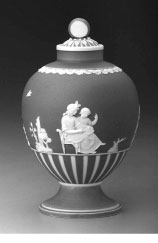Loveliness of ceramics
by Caryl Nugara
 |
|
A Grecien Urn |
 |
|
Jasperware |
 |
|
Meissen |
The term ‘ceramic’ comes from
the Greek word “keromos” which really means ‘earthenware’. When man
became civilised he wanted to have nice things in life. He first took a
ball of earth, shaped it like a pot and fired it at low heat. This was
perhaps the original rounded container used for domestic purposes. Then
the introduction of the ‘potter’s wheel’ and the creativity of the
potter influenced the making of nicer utensils from fired clay.
 |
|
A Meissen tea set |
 |
|
Ceramic tiles of
Alhambra Palace |
The Egyptians, Greeks and Babylonions made attractive red and black
pottery. Their knowledge spread to Rome and China. The Chinese produced
the real porcelain, opaque and unique. The finished products were
translucent and delicate. They were glazed, ornamented and even enriched
with gold and platinum. Brilliant figuriness like the Chinese Buddha,
the fisherman, the concubine and the war-lord are treasured pieces of
art.
The Greeks were famous for their ceramic urns while Spanish pottery
was decorated with mythological and Biblical scenes. A frenchman who
established a factory in the 17th century introduced embellishments like
scrolls, lace-work and motifs on his products. It was light and glossy
porcelain. Cretan vases were decorated with black and brown sea-weed and
octopus motifs. Persian pottery had glorious star and cross-shaped
fragment decorations in various colours. They had glazed tiles in their
mansions. Indeed the Alhambra Palace in Granada has fantastic enamelled
brick and terracotta ornamentation.
Later the Europeans learnt the method of ceramic making. Germany is
famous for its ‘Meissen’ curios while Holland’s (Dutch) artisans created
lovely ‘Delph-ware’ ornaments like the Dutch girl and boy, the little
house with chimney and small windows and exquisitely beautiful replicas
of the Dutch clogs. Dutch pottery with opaque white glaze had enchanting
details in blue of tulips, the windmill and the dyke out-lined in gold.
In the 18th century Josiah Wedgewood mass-produced tableware but his
work was not considered much. Then he fashioned some light green and
blue ‘jasper-ware’ with opaque quartz. The domestic articles he created
were so refined that Queen Charlotte of England and the Russian Empress
Catherine commissioned him to supply ‘Queensware’ for the palace.
Another skilful person introduced ‘bone china’ ware used in all parts of
the world.
Today we have imposing “art nou-veau” tableware in leaf, flower,
unusual shapes, some encased in filigree or ornamented with
gemstones.Anyway the porcelain and ceramics, aged and antiquated with
time retain their own, special creative loveliness. |

